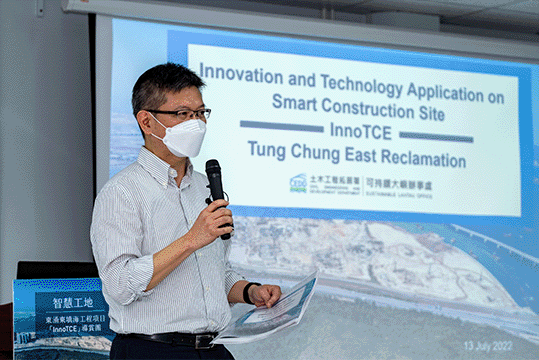2022.08.22
The making of a smart, green and resilient new town extension

Major development projects are often nurturing grounds for new construction methods as standard rises and practitioners strive to improve. Tung Chung New Town Extension is one of the major development projects where possibilities become reality.
Under the project, 130 hectares of new land is to be formed from reclamation in phases since 2020. New development areas as such adopt smart, green and resilient (SGR) city concepts, in accordance with the visions set out in the 2018 Policy Address. While it is envisioned that the project would demonstrate SGR features upon population intake, such features were already shown in the construction site as early as the reclamation stage. The following explains how the making of a new town extension itself is smart, green and resilient, using the Tung Chung new town extension as an example. The project adopts an integrated smart system with real-time monitoring sensors for project management, with measures taken to mitigate impacts to the environment and to bolster climate resilience of the project upon completion.
3.8 km eco-shoreline nurtures ecological inhabitants and coastal resilience
In an attempt to strike a balance between urban development and nature conservation, Hong Kong’s first eco-shoreline in public works projects, of 3.8km long, was proposed along the waterfront of Tung Chung New Town Extension project. Contrary to traditional concrete seawall, the eco-shoreline is considered a “living” seawall, which aims to enhance biodiversity, retain seawater and offer shelter for the inhabitation and growth of marine species. To suit the site setting, there are three types of eco-shorelines, namely Mangrove Eco-shoreline, Rocky Eco-shoreline and Vertical Eco-shoreline in the project. Although each of them is in different form, they all serve the same purpose of conserving living organisms. For example, the tidal rockpools formed by concrete bio-blocks inside the rocky eco-shoreline provide shelter and refuge for marine organisms by retaining water during low tide.
Before construction of the permanent works, an eco-shoreline trial site was set up in 2019 with mangroves planted and concrete bio-blocks installed. The trial aims to improve the arrangement and create a better habitat for the mangroves and marine organisms with mud flat and bio-blocks, which serve as shelter and refuge for marine organisms residing in intertidal habitats, such as crabs and gastropods. In the trial period of over 2 years, the findings are encouraging as many mangroves have been growing healthily and over 20 types of species have been found in the eco-shoreline habitat.
Similar eco-shorelines were also installed as trial in other parts of Hong Kong such as at the seawalls in Sai Kung, Tuen Mun, Ma Liu Shui, Tsuen Wanand Causeway Bay.
Real-time continuous compaction control reduces on-site manpower
A cloud-based, real-time, IoT-friendly Continuous Compaction Control (CCC) programme was adopted for trial in the filling process during reclamation with an aim to improve efficiency and reduce manpower for inspection and testing during reclamation.
Traditionally, upon compaction of fill materials, samples would be taken to the laboratory for determination of compaction level, in other word the ground stiffness. To enhance the process, the project team introduced a single drum roller and soil compactor with sensors which work in coherence to measure and record the response of the ground. It is a measurement of the ground stiffness real time during the compaction process, eliminating samples collection and waiting time for lab results. Furthermore, the compaction process and locations, via GPS, are recorded and shown in web-based platform.
Construction noise from sheet piling effectively controlled by Magnetic Tuned Mass Damper
The project proactively mitigates construction noise using Magnetic Tuned Mass Damper (MTMD), an innovative noise damper system, during the sheet piling works of West Sewage Pump Station in Tung Chung East. The application is the first of its kind in Hong Kong.
To mitigate the noise produced during the sheet piles driving process, a tailor-made MTMD was invented to dissipate the vibration of sheet pile by tuned mass damping mechanism, which reduces the amplitude of vibration when a strong force hit the sheet pile. By adjusting the stiffness of the resilient layer and the size of the oscillation masses, the MTMDs were tuned to absorb vibration energy that matches the most with the inherent frequency of the structure itself and cancels out resonant vibrations. As a result, the MTMDs had effectively reduced the noise level during sheet piling by around 9-14dB(A) when measured from various distance from the driven pile.
Many more innovative technologies were adopted in the Tung Chung New Town Extension project in a bid to digitise construction work to enhance operation efficiency, safety and site management for promoting the development of smart sites. Watch our third episode of our exclusive Smart Construction Site Series interview for more information.
